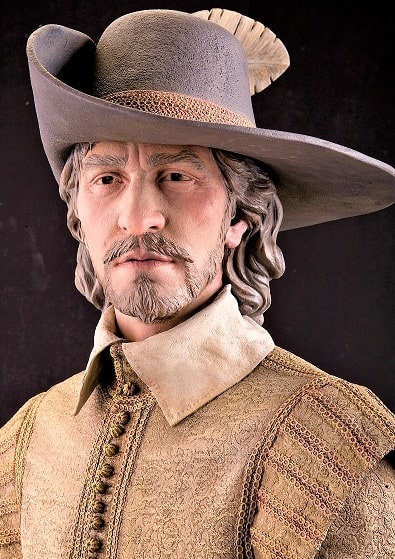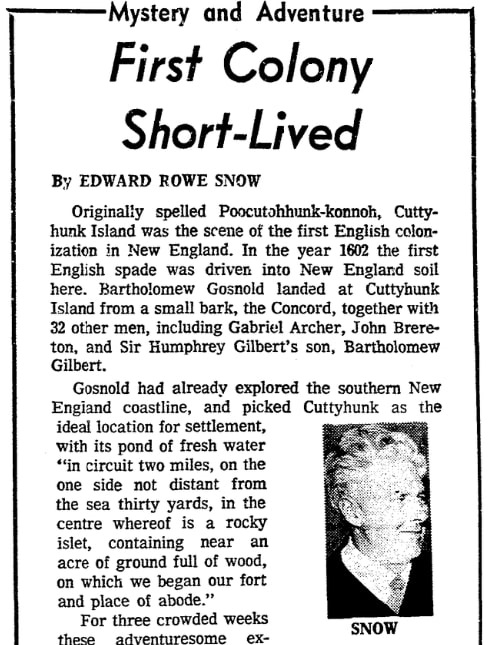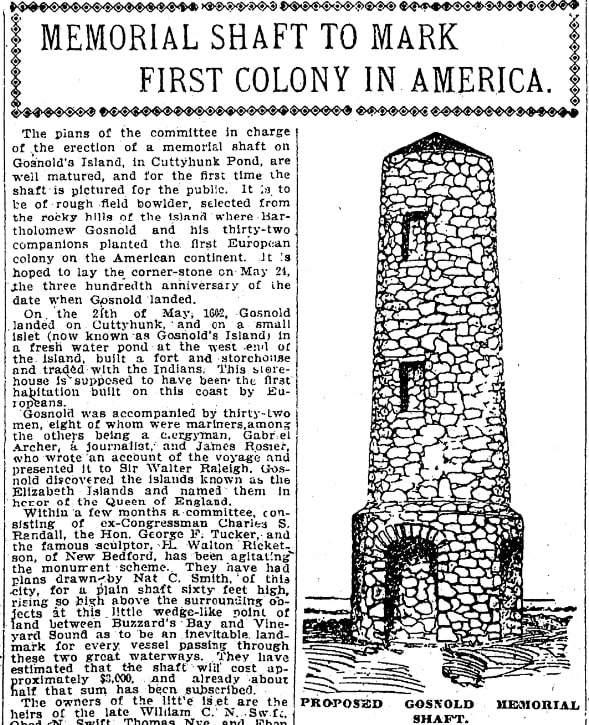Introduction: In this article, Melissa Davenport Berry writes about Bartholomew Gosnold, who founded the first colony in New England, in 1602, short-lived though it was. Melissa is a genealogist who has a blog, AnceStory Archives, and a Facebook group, New England Family Genealogy and History.
The English explorer Captain Bartholomew Gosnold has been largely forgotten and overlooked. He was the man who, along with a crew, set up a small colony in the New World 18 years before the landing of the Pilgrims in Plymouth. The colony was short-lived, but Capt Gosnold went on to be one of the most important figures in the founding of the Virginia colony Jamestown.

Note on the above illustration: This reconstructed image of Bartholomew Gosnold was used for Dr. Douglas Owsley’s exhibit “Written in Bone,” a popular exhibit at the Smithsonian Institution’s National Museum of Natural History that ran from 7 February 2009 to 6 January 2014. The exhibit examined history through forensic anthropological investigations of 17th century human skeletal remains, including: those of colonists teetering on the edge of survival at Jamestown, Virginia; those living in the wealthy and well-established settlement of St. Mary’s City, Maryland; and farmers located in Leavy Neck in Anne Arundel County, Maryland. Courtesy of the Department of Anthropology, National Museum of Natural History.
Capt. Gosnold was born to Anthony and Dorothy (nee Bacon) Gosnold. The country seat of the Gosnold family was Otley Hall in Otley, Suffolk, England.
Gosnold was instrumental in founding the Virginia Company in London and Jamestown in colonial America. He is listed as a qualifying ancestor for the Jamestowne Society. I will explore that story in Part 2.
Here is a look into Captain Gosnold’s 1602 adventure along the New England coast as told by the historian Edward Rowe Snow (1902-1982), published in the Boston Herald.

Snow wrote:
Originally spelled Poocutohhunk-konnoh, Cuttyhunk Island was the scene of the first English colonization in New England. In the year 1602 the first English spade was driven into New England soil here. Bartholomew Gosnold landed at Cuttyhunk Island from a small bark, the Concord, together with 32 other men, including Gabriel Archer, John Brereton, and Sir Humphrey Gilbert’s son, Bartholomew Gilbert.
Gosnold had already explored the southern New England coastline, and picked Cuttyhunk as the ideal location for settlement, with its pond of fresh water “in circuit two miles, on the one side not distant from the sea thirty yards, in the centre whereof is a rocky islet, containing near an acre of ground full of wood, on which we began our fort and place of abode.”
For three crowded weeks these adventuresome explorers stayed on Cuttyhunk Island, building a sedge-thatched house. They also constructed a flat-bottomed punt, on which they ferried men and materials across the lake to the inner island. Scores of exploring expeditions to the surrounding islands and mainland were carried out from their headquarters at Cuttyhunk.
They planted Martha’s Vineyard [named after his deceased daughter, Martha] with wheat, oats, and barley, while strawberries, raspberries, and gooseberries abounded in the region. “Scallops, Muscles, Cockles, Lobsters, Crabs, Oysters, and Wilks, exceedingly good and very great,” were eaten by these English pioneers. [Capt. Gosnold named the area Cape Cod for its plentiful fish.]
Their real discovery, however, was sassafras, which was a very expensive medical cure in England at that time [used to treat scurvy, skin sores, toothaches, syphilis, and many other ailments. Sir Walter Raleigh brought it back to England from the Virginia Colony, and in the early 17th century, English ships were sent to the colonies to collect sassafras roots. The trips became known as the “Great Sassafras Hunts.”] The Concord was loaded with sassafras and cedar wood for its return journey to England.
On May 25, 1602, Gabriel Archer mentions the arrival at Cuttyhunk Island of an Indian, his wife, and daughter. Five days later the Englishmen stole a canoe from the island of Hills Hap, near the mainland.
During the first week in June fifty Indians with their sachem [chief] arrived from the mainland in nine canoes, and the first New England fish dinner was given the Indians by Gosnold. A brief description of that feast at Cuttyhunk follows:
They misliked nothing but our mustard, whereat they made a sowre face… One of them had conveyed a target of ours into one of their canowes, which we suffered, only to trie whether they were in subjection to this leader who… caused it presently to be brought back again.
This incident seemed to cause a crisis in the banquet, but after the target, or shield, was returned to the white men, who then relaxed, the Indians followed suit and went back to roasting crabs and “red herrings, which were exceedingly great.”
On June 10 the Indians ambushed several of the settlers, one of whom was wounded in the side. Perhaps the incident of the stolen canoe had something to do with the affair, but at any rate the Englishmen were alarmed at the whole proceedings and a week later sailed away for England, which they reached July 23, 1602. New England’s first colony had ended.

In 1902 the Gosnold Monument, a seventy-foot stone tower, was built on the island to commemorate the tercentenary of Gosnold’s landing.
I found an article in the Cleveland Dealer detailing plans for the monument.

This article reported:
Within a few months a committee, consisting of ex-Congressman Charles. S. Randall, the Hon. George F. Tucker, and the famous sculptor H. Walton Ricketson, of New Bedford, has been agitating the monument scheme. They have had plans drawn by Nat C. Smith, of this city, for a plain shaft sixty feet high, rising so high above the surrounding objects at this little wedge-like point of land between Buzzard’s Bay and Vineyard Sound as to be an inevitable landmark for every vessel passing through these two great waterways. They have estimated that the shaft will cost approximately $3,000, and already about half that sum has been subscribed.
The owners of the little islet are the heirs of the late William C. N. Swift, Obed N. Swift, Thomas Nye, and Eben Perry, of New Bedford. They have consented to the erection of the shaft on the land if it is placed under the control of the Massachusetts Historical Society, and the organization has assented to take charge.
There is another story attached to Cuttyhunk Island and historian Snow: when he was fulfilling his duty as the “Flying Santa” who would drop packages of gifts to lighthouse keepers and their families stationed at remote places along the New England coast. Read more at Edward Snow: The ‘Flying Santa’ for Lighthouse Keepers.
To be continued…
There is more history on Bartholomew Gosnold at: Americana Archives.
Explore over 330 years of newspapers and historical records in GenealogyBank. Discover your family story! Start a 7-Day Free Trial.
Note on the header image: “Gosnold at Cuttyhunk, 1602” by Albert Bierstadt, 1858. Credit: New Bedford Whaling Museum; Wikimedia Commons.

Melissa, this is a great series; most people have no idea how significant Gosnold is to our country’s shaky beginnings. Thank you!
Thank you Elizabeth! Genealogybank.com newspaper archives have truly been a treasure trove for historical finds and Gosnold was such an important figure in early exploration of America.
Excellent article, Melissa Berry! I would like to know more about Gosnold. Interesting to read the history of places like Martha’s Vineyard and Cape Cod. Looking forward to more articles like this.
Thank you Denise! I so appreciate your feedback and I was stunned by all the history I found on Capt. Gosnold. He was an interesting man and contributed a great deal in early American exploration.